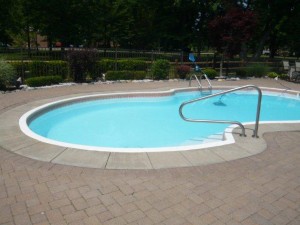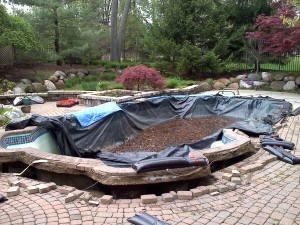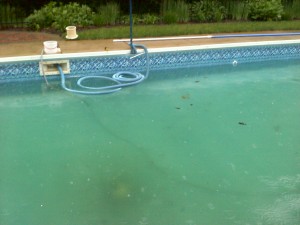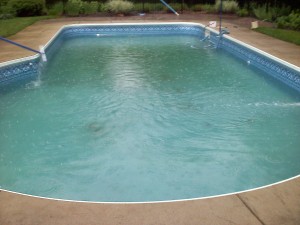We’ve already had calls this spring from homeowners who have taken water out of their pool with a pump themselves, and it’s causing some issues. We’ve had one call each on gunite, fiberglass, and vinyl. Here’s what’s happening.
Gunite Pool Pop-Out
The Gunite Pool was pumped out for the winter, though some water was left in the pool. Over the winter, the ground water forces were greater than the force of the water holding the pool in the ground and significant pop-out damage happened. It could have been a hydrostatic valve malfunction as well that contributed. This can be prevented by leaving your pool full to just below the returns when you winterize the pool and then let the water over the winter fill up your pool, either on top of the plastic cover, or through the mesh of a safety cover (this is the best choice).
Fiberglass Pool Crack
In the next pool, the homeowner was pumping the water off of their plastic cover, of a fiberglass pool. In this case, the pool didn’t pop, but it did shift and “twist” causing a crack in the surface of the fiberglass. This is a significant repair, if not complete tear out and redo situation. A fiberglass pool, especially in Michigan or areas with groundwater, you must keep the pool almost full at all times. The water level is usually left above a typical closing level in a fiberglass pool, for added insurance that it will remain in place where it is supposed to! Brick pavers around a pool are also a bad idea. They allow water to travel between the stones to settle at the bottom of the pool. Pools should have concrete around them, with the expansion joint caulked, and any drainage issues should be addressed so water drains away from the pool and into another area in the yard.
This is a fiberglass pool pop-out that happened in 2011. When plastic covers are used and a “sump” type pump is placed on top of a pool, typically by a homeowner, the water is pulled through the weave of the plastic cover, so while a homeowner thinks they are draining the cover only, they are actually draining the pool.
Vinyl Liner Pool
We had an early spring call from a vinyl liner pool homeowner this year. He was draining his pool cover with a pump and noticed the pool water level was significantly low. A vinyl liner pool suffers the least damage if it’s pumped out too low, but issues can occur. A liner can float, and wrinkle when the water below the pool shifts the liner out of place. The advice to the homeowner this spring was to bring in a truck or two of water right away, before waiting for the opening of the pool (scheduled for a month later), to prevent any issues from occurring. If you do end up with a floating liner (as the photos show), you can Ask the Pool Guy to help. He’s got a system to remove and reset most vinyl liners that have issues that still have some elasticity to them. The older a liner, the less change we have of this procedure being successful, and a liner replacement may be necessary.
When in doubt, hire a professional. Always make sure your pool has the optimum amount of water in it – it’s important!
















